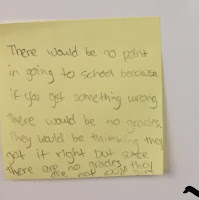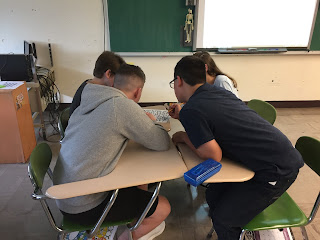Question of the Day: From yesterday: What is STEM?
From Today: What would school be like if there were no grades? Why grade homework?
Lesson Sequence:
- Which One Doesn't Belong? As part of proving what one didn't belong among 9, 16, 25, and 43 we discussed what a prime number is and what the square root of each number was. This proved pivotal when we moved to the discussion about grading and incentives.
- Quote of the day, question of the day, star students
- Sticky Talk. Technically the term for this protocol is Chalk Talk, but because we were using sticky notes I changed the name. This was where the lesson got interesting, so more on this below.
- Passed out the syllabus. Depending on how much time remained after the Chalk Talk, I gave all the students a highlighter and told them to read it as a group, but only to highlight three things on the syllabus (individuals within a group could highlight different things). I have always found that there is too much information in my syllabus, but I also have a hard time cutting out information. By forcing the students to choose three things I am letting them pick out what is most important.
- If time, discussed the group work from Day 1.
The first thing I had the students do with the sticky talk was divide the class in half to answer one of two questions silently at their desks on a sticky note:
- What would school be like if there were no grades? Or...
- Why is homework graded?
Next, students got up and put their sticky notes on the board or a piece of large chart paper which were at opposite ends of the classroom. For five minutes they read through the ideas of others. Again it is important to note that this was done silently. Students struggled with this because they are hormonal thirteen year olds and because they wanted to talk about the topic. I also chose to participate by asking questions and probing students thinking (although none of my questions or thoughts are in the responses below). Students had the opportunity to write their own questions and connect ideas to one another. After five minutes, students switched sides of the room and looked at the answers and questions their classmates had of the other question. Again, they had the opportunity to ask questions and I left extra sticky notes in case a new thought popped into their heads.
Here was some of the dialogue about what school would be like if there were no grades. These first two pictures was the most common theme I saw.
I like how a student wrote the comment in the marker instead of me. Here were some of the other ideas that cropped up about having no grades in school:
Here were some responses to the question about why homework is graded starting with my favorite.
Yes. I want you working 100% of the time. No sleeping. No texting. No dating. No snacks. No collecting $200. Just homework baby. Here were some more thoughts:
Regrets: The students did not have much room to read responses. By the fifth time of the day that I was doing this, I called students up by their groups of four instead of having twelve at a time. I think I could either have the question in two different parts of the room or just simply make the viewing space wider. That would curtail some of the mischief and foolery that was taking place when we were supposed to be silent.
In talking with my eighth grade math colleague, we both were finding ourselves asking the students what is the purpose of school in follow up discussions or even within the protocol. Students responded in huge numbers that there would be no purpose to school without grades and no sense in doing homework if it was not graded. Yet when we asked what the purpose of school was, students responded by saying it was to learn. Learning is what grades are ultimately supposed to measure. If I were to really zoom in on why the students would be in such an uproar in a school with no grades, what it really comes down to is their desire for feedback. And on that point I can't really argue - that is at the core of what grades are and why we have schools. How our brains are trained to interpret feedback versus grades - especially at the student level is where the traditional education system has lost its meaning.
Glass Half-Full: The rationale behind this entire lesson was that my colleague and I are going away from counting homework as part of the grading process. Originally we thought students would sell themselves on such an idea. And then as we got closer to this day we saw all of the potential resistance that this decision could bring as well.
The research is out there. And there's a lot of it with many contradictions. And there are many opinions too. See the sticky notes above. Not pictured are the parents and caretakers of the people who wrote on the sticky note. Ultimately for us as the teachers it was a matter of weighing grading homework versus not grading homework. The cons of grading homework were too great. It puts stress on families. It strips kids of play and opportunities to do extracurricular activities. It puts students from disadvantaged backgrounds at an even further disadvantage. As the educational consultant Rick Wormeli would have you know, it makes grades less informative since homework is typically graded on subjective measures like effort and completeness and not the standards. It encourages students (even against all warnings) to copy each other, which when founded leads to negative emotions for all stakeholders and when unfounded leads to inaccurate formative assessments. Homework gives kids more of a negative outlook on school. And for the students that would not do homework if it was not graded, they probably were not going to put a whole lot of sweat into it anyway since they were not intrinsically motivated. Not grading homework will save just a little time for the teachers in terms of putting it in the grade book - time that can be spent in the trenches on helping students get better at math. That is the job of a math teacher after all.
Inevitably we are going to run into problems with this system, but after doing this protocal I am more convinced we are taking the correct path. We are still going to give homework in a 2-4-2 format (see Steve Leinwand: Thoughts on Revising How We Assign and Review Homework), so we can still benefit from the positive outcomes that the students listed above. Students that do homework with good intentions will know what to work on, enhance their short term memory, and be more prepared for the test. The adults will become more concerned with the standard than the grade, will have a more accurate formative assessment, and maybe will lose that reputation for wanting to possess the soul of the student 100% of the time.
I wrote way more than I ever intended. Time for a weekend.














